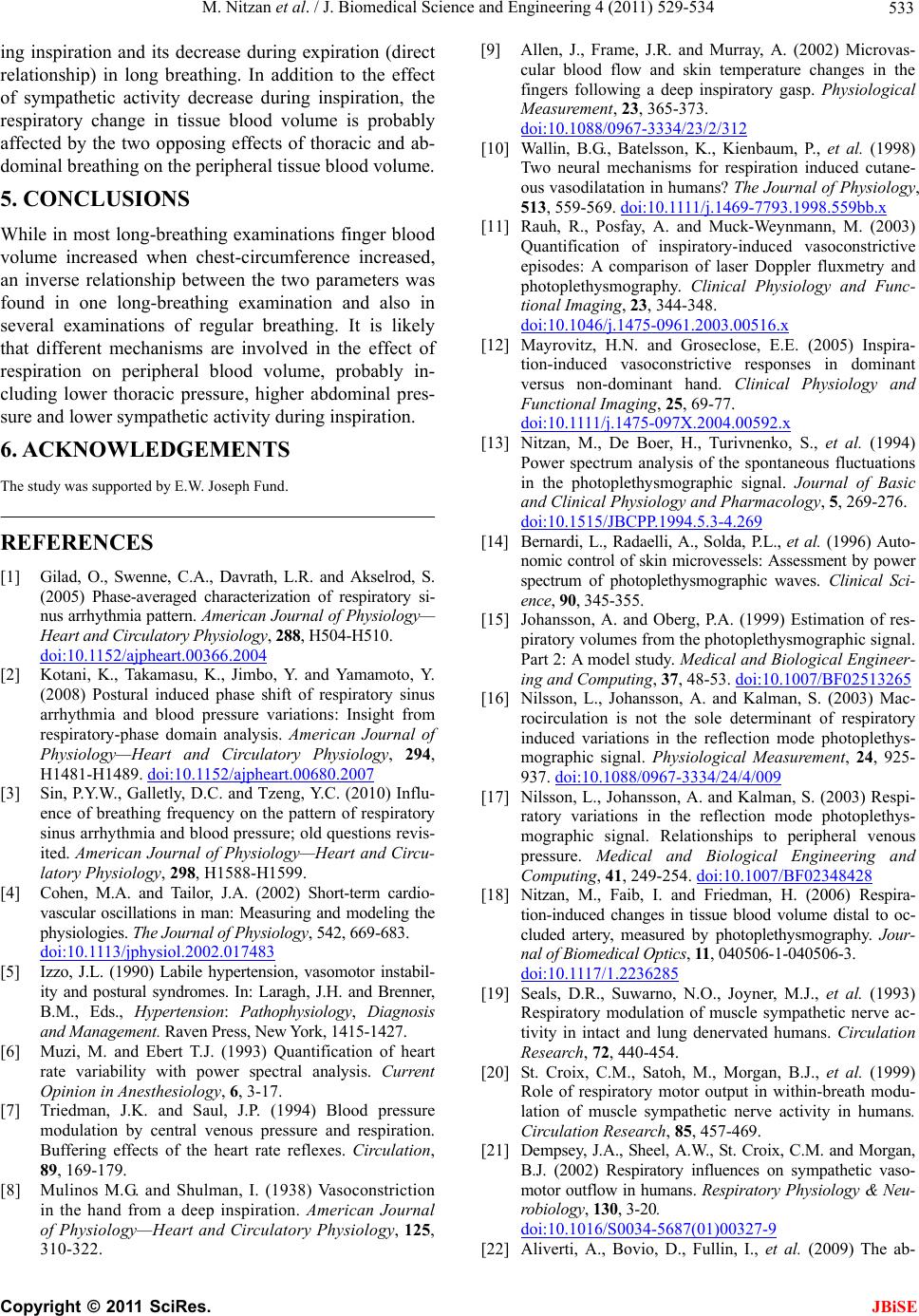
M. Nitzan et al. / J. Biomedical Science and Engineering 4 (2011) 529-534 533
ing inspiration and its decrease during expiration (direct
relationship) in long breathing. In addition to the effect
of sympathetic activity decrease during inspiration, the
respiratory change in tissue blood volume is probably
affected by the two opposing effects of thoracic and ab-
dominal breathing on the peripheral tissue blood volume.
5. CONCLUSIONS
While in most long-breathing examinations finger blood
volume increased when chest-circumference increased,
an inverse relationship between the two parameters was
found in one long-breathing examination and also in
several examinations of regular breathing. It is likely
that different mechanisms are involved in the effect of
respiration on peripheral blood volume, probably in-
cluding lower thoracic pressure, higher abdominal pres-
sure and lower sympathetic activity during inspiration.
6. ACKNOWLEDGEMENTS
The study was supported by E.W. Joseph Fun d.
REFERENCES
[1] Gilad, O., Swenne, C.A., Davrath, L.R. and Akselrod, S.
(2005) Phase-averaged characterization of respiratory si-
nus arrhythmia pattern. American Journal of Physiology—
Heart and Circulatory Physiology, 288, H504-H510.
doi:10.1152/ajpheart.00366.2004
[2] Kotani, K., Takamasu, K., Jimbo, Y. and Yamamoto, Y.
(2008) Postural induced phase shift of respiratory sinus
arrhythmia and blood pressure variations: Insight from
respiratory-phase domain analysis. American Journal of
Physiology—Heart and Circulatory Physiology, 294,
H1481-H1489. doi:10.1152/ajpheart.00680.2007
[3] Sin, P.Y.W., Galletly, D.C. and Tzeng, Y.C. (2010) Influ-
ence of breathing frequency on the pattern of respiratory
sinus arrhythmia and blood pressure; old questions revis-
ited. American Journal of Physiology—Heart and Circu-
latory Physiology, 298, H1588-H1599.
[4] Cohen, M.A. and Tailor, J.A. (2002) Short-term cardio-
vascular oscillations in man: Measuring and modeling the
physiologies. The Journal of Physiology, 542, 669-683.
doi:10.1113/jphysiol.2002.017483
[5] Izzo, J.L. (1990) Labile hypertension, vasomotor instabil-
ity and postural syndromes. In: Laragh, J.H. and Brenner,
B.M., Eds., Hypertension: Pathophysiology, Diagnosis
and Management. Raven Press, New York, 1415-1427.
[6] Muzi, M. and Ebert T.J. (1993) Quantification of heart
rate variability with power spectral analysis. Current
Opinion in Anesthesiology, 6, 3-17.
[7] Triedman, J.K. and Saul, J.P. (1994) Blood pressure
modulation by central venous pressure and respiration.
Buffering effects of the heart rate reflexes. Circulation,
89, 169-179.
[8] Mulinos M.G. and Shulman, I. (1938) Vasoconstriction
in the hand from a deep inspiration. American Journal
of Physiology—Heart and Circulatory Physiology, 125,
310-322.
[9] Allen, J., Frame, J.R. and Murray, A. (2002) Microvas-
cular blood flow and skin temperature changes in the
fingers following a deep inspiratory gasp. Physiological
Measurement, 23, 365-373.
doi:10.1088/0967-3334/23/2/312
[10] Wallin, B.G., Batelsson, K., Kienbaum, P., et al. (1998)
Two neural mechanisms for respiration induced cutane-
ous vasodilatation in humans? The Journal of Physiology,
513, 559-569. d oi:10.1111/j.146 9-7793.1998.559bb.x
[11] Rauh, R., Posfay, A. and Muck-Weynmann, M. (2003)
Quantification of inspiratory-induced vasoconstrictive
episodes: A comparison of laser Doppler fluxmetry and
photoplethysmography. Clinical Physiology and Func-
tional Imaging, 23, 344-348.
doi:10.1046/j.1475-0961.2003.00516.x
[12] Mayrovitz, H.N. and Groseclose, E.E. (2005) Inspira-
tion-induced vasoconstrictive responses in dominant
versus non-dominant hand. Clinical Physiology and
Functional Imaging, 25, 69-77.
doi:10.1111/j.1475-097X.2004.00592.x
[13] Nitzan, M., De Boer, H., Turivnenko, S., et al. (1994)
Power spectrum analysis of the spontaneous fluctuations
in the photoplethysmographic signal. Journal of Basic
and Clinical Physiology and Pharmacology, 5, 269-276.
doi:10.1515/JBCPP.1994.5.3-4.269
[14] Bernardi, L., Radaelli, A., Solda, P.L., et al. (1996) Auto-
nomic control of skin microvessels: Assessment by power
spectrum of photoplethysmographic waves. Clinical Sci-
ence, 90, 345-355.
[15] Johansson, A. and Oberg, P.A. (1999) Estimation of res-
piratory volumes from the photoplethysmographic signal.
Part 2: A model study. Medical and Biological Engineer-
ing and Computing, 37, 48-53. doi:10.1007/BF02513265
[16] Nilsson, L., Johansson, A. and Kalman, S. (2003) Mac-
rocirculation is not the sole determinant of respiratory
induced variations in the reflection mode photoplethys-
mographic signal. Physiological Measurement, 24, 925-
937. doi:10.1088/0967-3334/24/4/009
[17] Nilsson, L., Johansson, A. and Kalman, S. (2003) Respi-
ratory variations in the reflection mode photoplethys-
mographic signal. Relationships to peripheral venous
pressure. Medical and Biological Engineering and
Computing, 41, 249-254. doi:10.1007/BF02348428
[18] Nitzan, M., Faib, I. and Friedman, H. (2006) Respira-
tion-induced changes in tissue blood volume distal to oc-
cluded artery, measured by photoplethysmography. Jour-
nal of Biomedical Optics, 11, 040506-1-040506-3.
doi:10.1117/1.2236285
[19] Seals, D.R., Suwarno, N.O., Joyner, M.J., et al. (1993)
Respiratory modulation of muscle sympathetic nerve ac-
tivity in intact and lung denervated humans. Circulation
Research, 72, 440-454.
[20] St. Croix, C.M., Satoh, M., Morgan, B.J., et al. (1999)
Role of respiratory motor output in within-breath modu-
lation of muscle sympathetic nerve activity in humans.
Circulation Research, 85, 457-469.
[21] Dempsey, J.A., Sheel, A.W., St. Croix, C.M. and Morgan,
B.J. (2002) Respiratory influences on sympathetic vaso-
motor outflow in humans. Respiratory Physiology & Neu-
robiology, 130, 3-20.
doi:10.1016/S0034-5687(01)00327-9
[22] Aliverti, A., Bovio, D., Fullin, I., et al. (2009) The ab-
C
opyright © 2011 SciRes. JBiSE